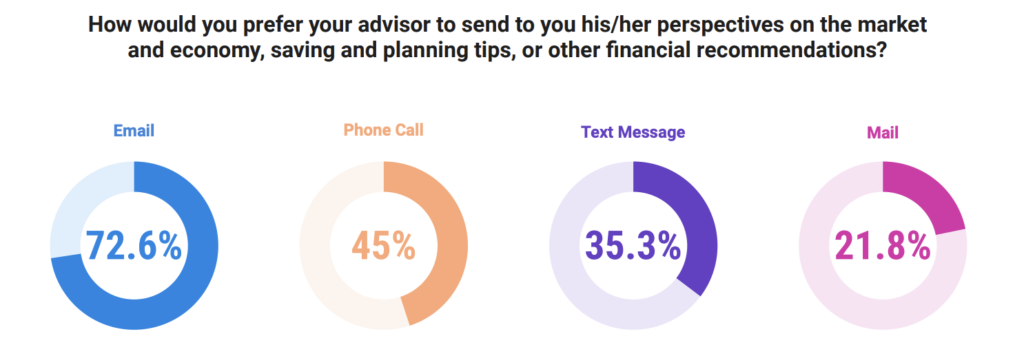Written by: Samantha Russell
According to the YCharts Client Communication Survey, email is the preferred communication channel for the majority of clients, and frequency and style of communication are essential to client retention.

So, how often should financial advisors email their clients? And what should they be sending?
The Importance of Sending Frequent Emails
There’s no doubt that email plays an important role in a financial advisor’s marketing strategy. Multiple studies show that email marketing results in a significant ROI. By sending your contacts messages on a regular basis, you stay top of mind, establish trust and credibility, show that you’re a leader in your industry, and encourage more referrals and connections.
Keeping your audience engaged is key if you want them to start and continue working with you. After all, no one fires their advisor for communicating too much, but they might if they communicate too little.
Determining Your Ideal Email Marketing Frequency
There are a few simple steps you can take right now to decide how many emails you should send each month. Start by asking yourself these questions:
1. What are my goals?
Why are you sending email campaigns? Is it to build loyalty and establish your branding? Or do you want to increase subscribers and convert more leads? If your main goal is to stay in communication with your audience, then you will likely send different content than if you’re trying to gain new business. This is expected but a good thing to note as you consider the objective of your communications.
2. What type of content am I sending?
The type of content you send has a major effect on your audience’s response and how often they expect to see emails from you. As an advisor, you can get away with sending frequent emails if you’re providing educational information, such as financial tips, market commentaries, event invites, or links to your latest blog post or timely content. Depending on your subscribers, you may send this type of content once per week.
3. Who are my subscribers?
Take a look at your email lists. Did they sign up for your emails? Or did you add them manually? Are they current clients or prospects? You may consider segmenting your lists to separate your newsletter subscribers from your general contacts or cold leads. If someone signed up for your emails, they likely expect frequent contact from you.
4. What are my average open, click-through and unsubscribe rates?
Worried your subscribers are experiencing email fatigue? This is when it’s good to turn to your analytics. When you send frequent emails, do you see an uptick in unsubscribes or a decrease in open rates? What kind of email content encourages higher open and click-through rates? Use this data to guide your email scheduling and content. Ideally, you want to aim for a 20% open rate, a 5% click-through rate and less than a 3% unsubscribe rate.
Evaluate, Test and Reevaluate
Use these questions to guide your email marketing decisions. For many advisors, one or two emails per month will suffice. But depending on your market and goals, you may choose to email more or less frequently. Remember, these steps serve as guidelines. You can always adjust your schedule and change your email habits based on the results you see. Get in the habit of reviewing your email analytics once per month to see how people are responding. And don’t be afraid to reach out to your top clients or closest colleagues to take their temperature and ask for feedback.
Related: How To Use Google Search Console to Track and Improve SEO Performance


